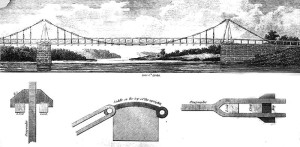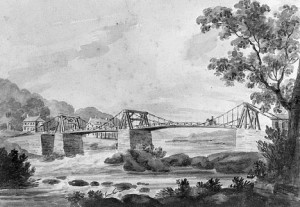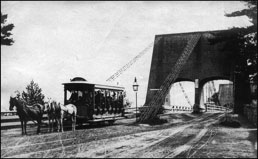This is the first in a series on early suspension bridges. It starts with James Finley (STRUCTURE, November 2008), who designed and built the first iron chain suspension bridge (1801-1802) with a horizontal deck across Jacob’s Creek just south of Mount Pleasant, Pennsylvania on Old Route 119. Chain bridges with a deck resting directly on the chain had been built for years, but were only for pedestrian traffic. Finley’s bridge was designed for carriages and wagons, as well as pedestrians, cattle, etc. It was a small bridge with a central span of only 70 feet, a deck 12 feet 6 inches wide and towers 14 feet high. His chains consisted of hand forged wrought iron loops much like paper clips, except the bars were square rather than round in section. His towers were built of wooden timbers and continuous stringers, and a heavy wooden rail stiffened the wooden deck. Its suspenders were also wrought iron loops of varying lengths. The bridge, first of its kind anywhere in the world, was built for $600 with the cost shared by the two abutting counties, Fayette and Westmoreland. He warranted the bridge to last for fifty years. A local newspaper, dated May 22, 1802, wrote:
“The Bridge, which Judge Finley (near this place) had undertaken to erect across Jacob’s creek, at the expense of Fayette and Westmoreland counties, near Judge Mason’s on the great road leading from Uniontown to Greensburg, is now completed. Its construction is on principles entirely new, and is perhaps the only one of the kind in the world. It is soley supported by two iron chains, extended over four piers, 14 feet higher than the bridge, fastened in the ground at the ends, describing a curve line, touching the level of the bridge in the center…The projector has made many experiments to ascertain the real strength of iron, and asserts that an inch square bar of tolerable iron in this position will bear between 30 and 40 tons; and, of course, less than one-eighth part of the iron employed in this bridge would be sufficient to bear the net weight thereof, being about 12 or 13 tons.”
Another bridge like it was not built for six years, when his plan was used for a replacement bridge in 1807 for Timothy Palmer’s bridge at the Little Falls on the Potomac River near Georgetown. He was awarded a patent on the bridge on June 17, 1808 as patent no. X883. It was the seventh patent issued for a bridge following patents by Palmer, Burr and Pope. All records of the patent were lost in a fire in 1836, but a lengthy description of how he designed and built his bridges, published in The Port Folio in June 1810, was probably similar to his patent application. This article, in the writer’s opinion, was the finest piece of engineering literature of its time. He wrote of his bridge:
“The bridge is solely supported by two iron chains, one on each side, the ends being well secured in the ground, and the chains raised over piers of a sufficient height erected on the abutments at each side, extended so slack as to describe a curve, so that the two middle joists of the lower tier [cross beams] may rest on the chains. The other joists of the same tier are attached to the chains by iron pendants of different lengths so as to form a level of the whole. In order that the chain may support as much weight as it could bear, when hung with the weight attached to the end of it, the piers must be so high as to give the chain a sinking or curve of the one full seventh of the span. The ends of the chains must descend from the tops of the piers with the same inclination that they take inwards, until each end reaches the bottom of a digging, large enough to contain stones and other materials sufficient to counterbalance the weight of the bridge and what may chance to be thereon. The chains, if only one to a side, must be made with four branches at each end, to be let down through as many stones, and to be bolted below. These stones are laid flat on the bottom of the digging; other flat stones may be placed thereon, to bind and connect the whole, that they may have the same effect as a platform of one piece; four or more joists will be necessary for the upper tier [stringers] – to extend from end to end of the bridge – each will consist of more than one piece; the pieces had best pass each other side by side, so that the ends may rest on different joists on the lower tier. The splice will then extend from one joist to another of the lower tier, and must be bolted together by one bolt at each end of the splice…”
In his article, he indicated that his plan was not only used on the Schuylkill Falls Bridge but ones over the Potomac River at Cumberland and Georgetown, the Brandywine, two near Brownsville and one over the Neshaminy Creek north of Philadelphia.

Image from The Port Folio for a 200-foot span that was part of a multiple span bridge like the Schuylkill Falls Bridge. Lower right and left indicate how Finley would connect his suspenders to the chain. The lower middle detail is at the top of the wooden tower showing the links connected to a saddle with pins.
A bridge across the rapids or Schuylkill Falls was authorized by the Pennsylvania Legislature on February 22, 1808 with Robert Kennedy and Conrad Carpenter as the proprietors. The only bridge across the Schuylkill River near Philadelphia was Timothy Palmer’s Permanent Bridge (STRUCTURE, October 2013) at Market Street, built in 1804. The falls were about five miles upstream from the Permanent Bridge. John Templeman, then working with James Finley as his exclusive agent, built the bridge across the river in 1809. In the Port Folio article Finley wrote, “In March 1808 I entered into an agreement with Mr. John Templeman of Georgetown, Maryland, by which he was to receive one half of all the monies arising from what permits or patent rights he could dispose of for and during the term of five years. All contracts to be in my name, and the money payable only to my agent in the city of Washington, who should pay one moiety over to Mr. Templeman.” His normal patent fee was $1 per foot of bridge. (Note: In the early 1800s, the term moiety was commonly used to denote a half.)
Finley must have had a hard sell to convince Kennedy and Carpenter to utilize a relatively untried design, when they could have contacted Timothy Palmer who had built major wooden bridges across the Merrimack, Schuylkill, Potomac and Delaware Rivers, or Theodore Burr who had built major bridges across the Hudson, Mohawk and Delaware Rivers. Finley was critical of Palmer’s Permanent Bridge, writing, “An estimate on these principles for a bridge of 500 feet between the abutments, with only one pier, will not amount to seven thousand dollars, exclusive of abutments and pier. Compare this with the Philadelphia Schuylkill bridge of the same extent, which cost sixty-five thousand dollars after the abutments and the two piers were completed; total expense, three hundred thousand dollars.” He also compared his bridge to two iron bridges in England, the Coalbrookdale and Sunderland Bridges, and indicated how little iron his bridge, with iron in tension, used compared to those with iron in compression. As to stone, he wrote, “May I venture to glance at the grand, the majestic arch of solid stone, with any idea of contrast between it and our simple contrivance? Happy for me, utility, economy and despatch, are the ruling passions of the day, and will always take preference of expense, idle elegance and show, until the minds of men become contaminated with vanity or some worse passion.” He capped off his argument with, “It is remarkable that in a science that has been maturing for thousands of years, and in which nothing is undertaken but by those who have been regularly brought up to the business, we should hear of so many misfortunes, and so much want of skill! Upon the whole, will it not be allowed that the best material has been chosen, (iron) the strongest and cheapest metal in the world – and applied in that way in which it possesses an hundred fold more power than it does in other positions?” Evidently his argument was successful, as he was given the contract to build the superstructure.

Svinin – Schuylkill Falls Bridge Finley Design, built by Templeman, from Picturesque United States of America, 1811, 1812, 1913, Being a Memoir of Paul Svinin.
The actual span lengths are not clear. Finley wrote the bridge was 306 feet long with one pier. Templeman wrote, “The bridge…at the falls of Schuylkill has three spans, two of which are 153 feet long, and could have been extended much farther.” Svinin’s image seems to back up Templeman’s description. Some sources indicate the spans were 200 and 100 feet, which makes some sense as Svinin’s drawing indicates the two suspension spans were of different lengths. Since the short span was of beam construction, maybe Finley did not consider it part of his chain bridge. Why they would build the extra pier so close to the abutment and why they made the spans of different lengths, if they did, is not clear from the record. The most likely dimensions are the ones given by Templeman. The chains were made of 1½-inch-square iron bars wrought into links of between 8 (Finley’s panels were 8 feet long and the center panel was horizontal and 8 feet long) and 12 feet in length. The vertical suspenders were also loops made of 1½-inch square bars. The suspenders were attached to 5-by 10-inch wooden cross beams spaced 8 feet apart. The stringers probably were about 3 by 12 inches. The wooden deck was 2½ inches thick. Templeman further wrote, “the chain bridge at the falls of Schuylkill cost only 20,000 dollars including two abutments and two piers of hewn stone” and claimed “the chains and uprights of which will last a couple of hundred years, – the first being painted, and the latter covered with a roof – There will be of course only the flooring and railing of the Bridge, subject to decay – the renewal of which will amount to mere nothing.” In 1811, Finley also wrote a follow up 13 page pamphlet entitled, “A description of the chain bridge: invented by Judge Finley of Fayette County Pennsylvania with data and remarks illustrative of the power, cost, durability, and comparative superiority of this mode of bridging.”
In September, just after the bridge opened, some suspenders broke and a portion of the floor fell into the river. This was quickly repaired. The bridge then collapsed in 1810 after only being up for about one year. The United States Gazette wrote “as a drove of cattle were passing across the bridge at the falls of Schuylkill, the works suddenly gave way and part of the superstructure fell into the river.” Finley, after inspecting the failure, and in order to maintain public confidence in his bridges, wrote a letter published in the January 17, 1811 United States Gazette in which he noted that the contractor had built the bridge contrary to his requirements. The Finley statement is in part as follows:
“Having recently been informed of some disaster befalling the chain bridges it becomes necessary for me to make a few cursory remarks, as to the cause of such failure.
The breach of the Schuylkill Bridge, by a drove of cattle, is an occurrence that deserves some attention. In giving a short explanation I invite the strictest scrutiny, and pledge my veracity for the correctness of the following statement.
And, the first thing to be observed is, that it was not a link nor any part of the chain properly so called, that broke; but an ill judged clip or coupling piece, with which two parts of the chain were joined together. Now it is indispensably necessary that these open hooks be removed, as well as some other improper substitutes, and let the connecting parts be as strong as any part of the chain itself; and two hundred tons burthen will make no considerable impression upon it. Great allowance must be made for the undertaker in this case; the principles being but little understood at that time; the workmen had never seen any thing of the kind, and had scarcely the shadow of information.”
Finley also followed up on Templeman’s March 14, 1809 Circular in a letter to the United States Gazette, in which he wrote:
“But the chain bridge is a doubtful thing. What then is the wooden frame bridge, consisting of two or three hundred tons of timber? View the upper and under framing – its hundreds of ties and bracings in every direction; what is the task of each and how much more can they bear? What burden can the bridge support independently of its own weight – or is not the huge mass of which it is composed a sufficient burthen almost for it; – In short the whole structure is so complex that nothing but loose conjecture can say any thing about it. Not so with the chain bridge, there are sufficient data for the strength and burden of its parts…let me further remark that, while the wooden bridge is the more in jeopardy the farther it is extended; the chain bridge on the contrary, becomes the more strong and secure the greater its extent. (US Gazette, January 17, 1811)”
The bridge failed again under a load of ice and snow on January 16, 1816. The United States Gazette again reported on the failure: “The Chain Bridge at the Falls of Schuylkill fell down about five o’clock on Wednesday morning. This unfortunate occurrence is said to have been occasioned by the great weight of snow which remained on it, and a decayed piece of timber. There was no person on the bridge when it fell.”
Some of Finley’s bridges lasted much longer. Perhaps the best known was the bridge across the Merrimack River outside of Newburyport, Massachusetts. Timothy Palmer had built a wooden bridge across the river in 1792 (STRUCTURE, June 2013). By 1812 some decay had set in, and the long span of 160 feet on the southerly side of the river was replaced with a 244-foot bridge built by John Templeman. It had a partial collapse in 1827, but was rebuilt and used until 1907 when a lookalike bridge was built. Thomas Pope described this bridge in his 1811 book Treatise on Bridge Architecture, and brought it to the attention of the world.
The original Jacob’s Creek Bridge was replaced in 1833 after a life of 31 years. While Finley’s bridges were unprecedented in terms of their design, they were a little ahead of their time. They were built by some men who did not understand Finley’s design, resulting in many failures. His designs, however, were picked up in England and France and modified. In England, Samuel Brown and Thomas Telford designed iron chain suspension bridges with horizontal decks in the 1820s. Their chains, however, were not built up of loops but were links connected by pins. Joseph L. E. Cordier, in his 1820 book Historie de la Navigation Intérieure, described the Finley Bridge. The Sequin Brothers in France picked up on the idea but used wire cables instead of iron chains. For his work, Finley is frequently called the Father of the Modern Suspension Bridge.▪

